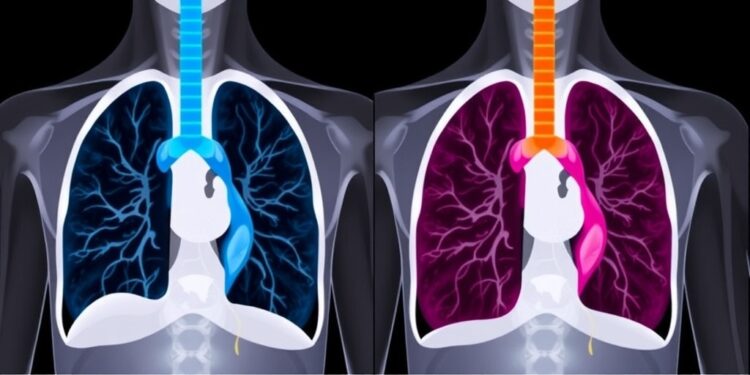
Recent advancements in the understanding of postoperative adjuvant radiotherapy (PORT) for patients suffering from pN2 non-small cell lung cancer (NSCLC) have illuminated the complexity of treatment strategies and their potential impact on survival outcomes. Historically, the role of adjuvant therapies following surgical intervention has been a topic of considerable debate; however, recent findings suggest a paradigm shift could be on the horizon. The study analyzed data from the renowned SEER-17 registry, revealing invaluable insights into how examined lymph nodes (ELNs) and lymph node ratios (LNR) contribute to PORT’s efficacy in this patient population.
The comprehensive multicenter retrospective cohort study conducted from 2015 to 2019 incorporated an impressive sample size of 1,875 patients who underwent surgical procedures coupled with lymph node biopsies. This study meticulously excluded individuals with incomplete data, ensuring the reliability of its conclusions. The application of advanced statistical analyses, such as Cox proportional hazards models alongside X-tile software, afforded a methodical approach to categorizing LNR. Through these means, the research team uncovered the significant improvement PORT confers on overall survival rates in the studied cohort.
The stark results of the study indicated that individuals who received PORT experienced improved survival compared to those who did not. Specifically, the findings revealed that the non-PORT group exhibited a 22% higher mortality rate, underscoring the critical need for implementing adjuvant radiotherapy in treatment protocols. With further granularity, models fully adjusted for confounding variables showed an alarming 31% increase in mortality for the non-PORT cohort. These findings were supported by Kaplan-Meier survival curves, which illustrated the stark differences in survival between those who received PORT and those who did not.
Intriguingly, the study highlighted that patients presenting with fewer than ten ELNs demonstrated marked benefit from PORT, especially when considering specific LNR categorizations. For patients with an LNR of 0.2 or less, the hazard ratio indicated a 4.15-fold increase in survival benefit associated with PORT. Conversely, those with an LNR of 0.53 or greater also experienced significant advantages, with a hazard ratio of 1.83. This nuanced understanding of the relationship between LNR, ELNs, and PORT efficacy paves the way for more individualized patient care and tailored treatment strategies.
The implications of these findings are profound, prompting a reevaluation of treatment paradigms in the management of pN2 NSCLC. With the growing recognition of the importance of personalized medicine, oncologists are encouraged to utilize ELNs and LNR as vital indicators when considering the inclusion of PORT in their treatment regimens. This could ensure that patients most likely to benefit from adjuvant therapy are not overlooked, potentially leading to improved overall survival outcomes.
As clinical practices evolve in response to this research, it becomes crucial for healthcare providers to engage in ongoing training and education regarding the latest evidence-based strategies in cancer treatment. Understanding the parameters set forth by this study will necessitate a shift in how postoperative care is approached for NSCLC patients, positioning PORT as a standard consideration, especially among those with specific lymph node characteristics.
Moreover, the wealth of data derived from large-scale studies such as the SEER-17 registry exemplifies the power of comprehensive statistical analyses in shaping clinical guidelines. These retrospective analyses, while often viewed with skepticism, provide clinicians with the opportunity to forge a clearer path based on large sample sizes that reflect real-world patient demographics. Consequently, this study serves not only as a foundation for future investigations but as a catalyst for immediate clinical translation.
In addition to survival implications, the study calls attention to broader oncological implications. Adoption of enhanced PORT regimens based on ELNs and LNR could lead to refined criteria for surgical interventions in NSCLC cases. This carries the potential to reduce unnecessary surgeries or enhance perioperative management strategies that incorporate targeted adjuvant treatments. As we expand our understanding of tumor biology and the nuances of cancer metastasis, integrating findings from pivotal studies like this could lead to real change in treatment methodologies.
Furthermore, while the data shines a hopeful light on improving survival rates among pN2 NSCLC patients, it also underscores the necessity of ongoing research. Future studies will need to further clarify which subpopulations benefit most from PORT, ultimately guiding oncologists in their treatment decision-making. Questions remain regarding the optimal timing, dosage, and specific protocols for PORT, and these variables will require further exploration in the context of emerging therapies and personalized medicine approaches.
In light of the growing body of evidence supporting the use of PORT in pN2 NSCLC, stakeholders across the healthcare landscape must prioritize communication and collaboration. Engaging in multidisciplinary discussions involving surgeons, medical oncologists, radiation oncologists, and pathologists will be essential to harmonizing treatment efforts and ensuring that all relevant factors are considered in patient care.
As awareness surrounding this significant research grows, it is expected that patient outcomes will improve as a direct result of enhanced treatment protocols and strategies adopted by healthcare providers. It is pivotal for both the medical community and patients alike to stay informed and proactive in understanding the implications of these findings for the future of lung cancer treatment.
The confluence of innovative research and clinical practice has the potential to change the trajectory of conversational landscape standards of care. As our understanding of pN2 NSCLC continues to evolve, PORT, guided by ELNs and LNR, stands to offer hope and improved outcomes for many patients navigating the complexities of cancer treatment.
Thus, as we move forward, we must embrace the evolving data and foster an environment where patient-centered care becomes the cornerstone of all cancer treatment plans. The study’s revelations regarding PORT and lymph node metrics herald a new era of oncological management that could redefine survival expectations, reinforce collaborative practices, and enhance quality of life for patients with pN2 NSCLC heading into the future.
Subject of Research: People
Article Title: Recommended optimal range for the count of examined lymph nodes and lymph node ratio for postoperative adjuvant radiotherapy in patients with pN2 non-small cell lung cancer: a multicenter retrospective cohort investigation
News Publication Date: 28-Feb-2025
Web References: Journal of Thoracic Disease
References: None
Image Credits: None
Keywords: Non-small cell lung cancer, postoperative adjuvant radiotherapy, examined lymph nodes, lymph node ratio, survival outcomes, statistical analysis
Tags: advanced statistical methods in cancer researchefficacy of PORT in cancerexamined lymph nodes significanceimproving overall survival rateslymph node ratio impactmulticenter retrospective studyoptimal lymph node examinationpN2 non-small cell lung cancerpostoperative adjuvant radiotherapySEER-17 registry analysissurvival outcomes in lung cancertreatment strategies for NSCLC





